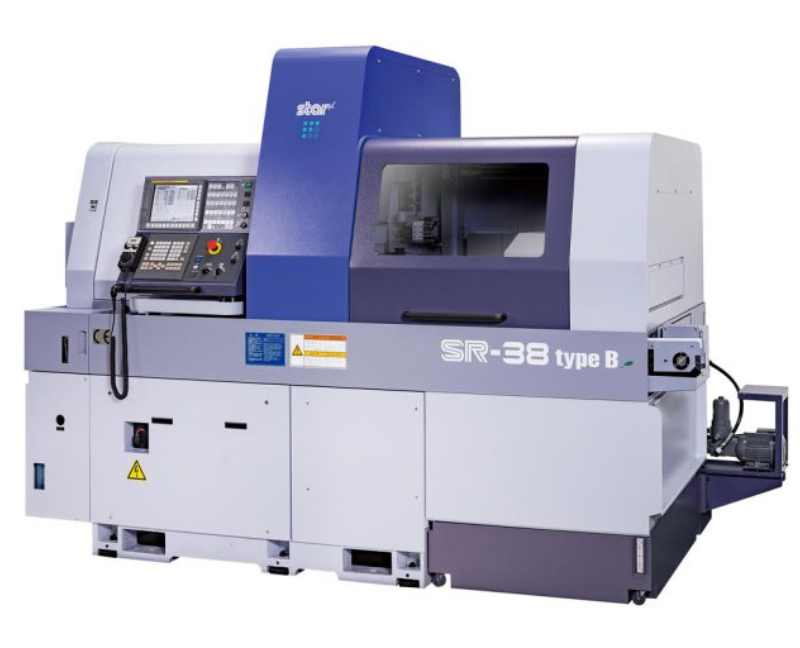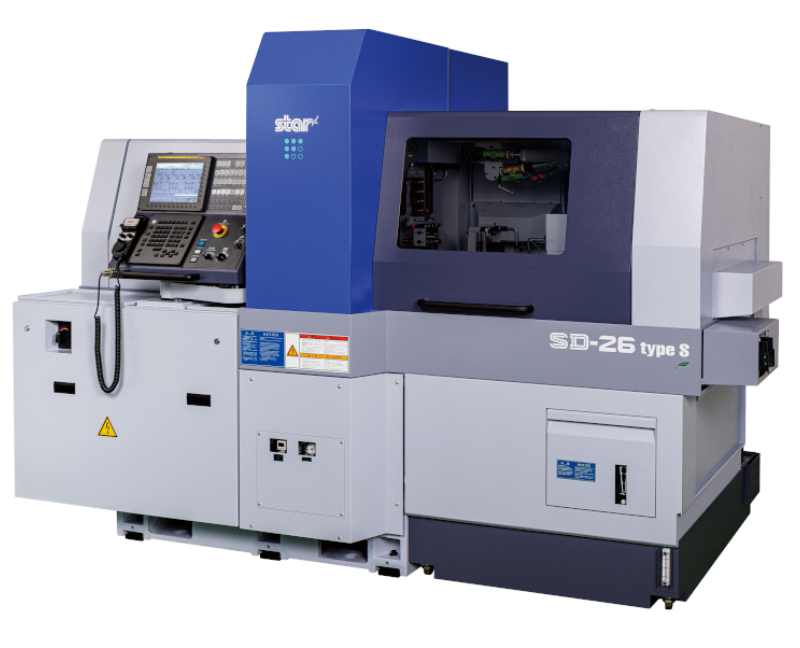Swiss-type automatic lathes, exemplified by Star CNC machines, have been a cornerstone of precision machining for over 65 years. These machines excel in producing small, intricate parts with tolerances as tight as ±0.002 mm, serving industries like medical, aerospace, automotive, and metalworking. Models such as the SX-38, SD-26, and SL-10 handle bar diameters up to 42 mm, incorporating features like multi-axis control and high tool capacity. When paired with FMB bar feeders, these lathes enhance accuracy and reduce cycle times by 20–30%. This guide explores the technology, specifications, and applications of Star CNC Swiss-type lathes, providing detailed parameters and insights into their role in modern manufacturing.
Overview of Swiss-Type Lathe Technology
Swiss-type lathes, also known as sliding headstock lathes, are designed for high-precision machining of small-diameter parts with complex geometries. Their sliding headstock and guide bushing system provide stability, enabling the production of slender components with length-to-diameter ratios up to 20:1. Star CNC has led this field, integrating innovations to achieve surface finishes as fine as Ra 0.4 μm and meet the demands of industries requiring intricate components.
Key Features of Swiss-Type Lathes
Swiss-type lathes are characterized by several technical attributes:
- Guide Bushing System: Supports the workpiece near the cutting tool, minimizing deflection and achieving tolerances of ±0.002–0.005 mm.
- Multi-Axis Control: Up to 12 axes enable simultaneous turning, milling, and drilling.
- High Tool Capacity: Accommodates up to 80 tools for flexible machining.
- High-Speed Spindles: Operate at speeds up to 15,000 RPM for rapid material removal.
Role of FMB Bar Feeders
FMB bar feeders enhance Star CNC lathes by automating material loading for bar stock diameters from 0.8–42 mm. They reduce downtime by 15–25% and maintain positional accuracy within ±0.01 mm through vibration-dampening systems, ensuring consistent part quality.
Industry Applications
Star CNC lathes are integral to industries requiring precision components:
- Medical: Producing surgical instruments with tolerances of ±0.002 mm.
- Aerospace: Machining alloy components with surface finishes of Ra 0.4–0.8 μm.
- Automotive: Manufacturing fuel injector nozzles with cycle times of 10–30 seconds.
- Metalworking: Creating complex connectors and fittings.

Star SX-38 Type A/B CNC Swiss-Type Lathe
The Star SX-38 Type A/B is a 12-axis Swiss-type lathe designed for machining challenging materials like titanium and stainless steel, with bar diameters up to 42 mm. Its slant-bed construction enhances rigidity, supporting heavy metal removal and complex part production.
Technical Specifications
The SX-38 offers advanced capabilities:
- Axis Configuration: 12 axes, including B-axis with 135° travel.
- Tool Capacity: Up to 80 tools with gang-type and turret-type posts.
- Spindle Speed: Main and sub-spindles up to 9,000 RPM.
- Tooling Size: Supports 0.5-inch (12.7 mm) diameter tools.
It achieves tolerances of ±0.003 mm and surface finishes of Ra 0.6 μm.
Applications
The SX-38 is suited for:
- Medical: Producing orthopedic screws with intricate threads.
- Automotive: Machining gears with cycle times of 15–20 seconds.
- Aerospace: Creating turbine fittings with tolerances of ±0.002 mm.
The B-axis enables 5-axis machining, improving efficiency by 20%.
Design Advantages
The slant-bed design minimizes thermal distortion, maintaining accuracy during runs. High-horsepower motors (7.5 kW) enable material removal rates up to 50 cm³/min for alloys like Inconel.
Star SD-26 Swiss-Type Automatic Lathe
The Star SD-26 is designed for complex parts up to 26 mm in diameter, with a reconfigured structure for improved access and advanced programming features.
Technical Specifications
Key features include:
- Dual B-Axes: B1 and B2 with 135° travel for 5-axis control.
- Tooling Units: B1 axis with 4-spindle milling; B2 axis with twin-thread whirling and brake.
- Spindle Speed: Up to 10,000 RPM.
- Control System: NC program batch input/output with command help functions.
It achieves tolerances of ±0.002 mm and cycle times of 10 seconds.
Applications
The SD-26 serves:
- Medical: Machining micro-surgical tools with 0.1 mm pitch accuracy.
- Electronics: Producing connectors with finishes of Ra 0.4 μm.
- Automotive: Creating valve components with 5-axis machining.
The whirling unit reduces secondary operations by 30%.
Design Advantages
Improved guide bushing access reduces setup times by 15%. The command help function minimizes programming errors by 10%.

Star SL-10 CNC Swiss-Type Automatic Lathe
The Star SL-10 is a compact lathe for small-diameter machining up to 10 mm, offering advanced technology in a small footprint.
Technical Specifications
Features include:
- Axis Setup: 6 axes with 5-spindle cross-drilling and 6-spindle back-working units.
- Spindle Speed: Up to 12,000 RPM.
- Bar Capacity: 10 mm.
- Footprint: 1.8 x 0.9 x 1.7 m.
It achieves tolerances of ±0.0015 mm and finishes of Ra 0.3 μm.
Applications
The SL-10 is ideal for:
- Medical: Producing dental screws with 0.05 mm features.
- Electronics: Machining micro-connectors with cycle times of 5–10 seconds.
- Watchmaking: Creating gears with tolerances of ±0.001 mm.
The back-working unit reduces handling by 25%.
Design Advantages
The compact design optimizes space, while high-speed spindles enable material removal rates up to 20 cm³/min. Y-axis control enhances milling accuracy to ±0.002 mm.
Advantages of Star CNC Swiss-Type Lathes
Star CNC lathes offer distinct advantages for precision machining.
High Precision and Accuracy
Tolerances of ±0.0015–0.003 mm meet medical and aerospace standards. Control systems ensure repeatability within ±0.001 mm.
Versatility
Handling bar diameters from 0.8–42 mm and up to 80 tools, these lathes support complex operations like 5-axis milling and thread whirling.
Efficiency
High-speed spindles and bar feeders reduce cycle times by 20–30%, with cycle times of 5–30 seconds. Batch programming saves 10–15% in setup time.
Challenges and Solutions in Swiss-Type Machining
Swiss-type machining faces challenges that require specialized solutions.
Tool Wear
Machining titanium reduces tool life to 2–4 hours. Coated carbide or CBN tools and cutting speeds of 100–200 m/min extend life by 20–30%.
Thermal Management
High-speed machining causes thermal distortion. High-pressure coolant (70–100 bar) reduces temperatures by 20%, maintaining tolerances of ±0.002 mm.
Complex Programming
Multi-axis operations require intricate NC programming. Command help functions reduce errors by 10% and setup times by 15%.
Future Trends in Swiss-Type Lathes
Advancements are enhancing Swiss-type lathe capabilities.
Automation and Industry 4.0
IoT integration and monitoring reduce defects by 15%. Automated tool changers increase throughput by 20%.
Enhanced Multi-Axis Control
Models with 14 axes and 6-axis machining reduce cycle times by 10–15%.
Material Versatility
Spindle power of 10–15 kW enables machining ceramics, with removal rates up to 30 cm³/min.
FAQ: Star CNC Swiss-Type Lathes
What are Star CNC Swiss-type lathes?
Star CNC Swiss-type lathes are precision machining tools for small, complex parts with tolerances of ±0.0015–0.003 mm, used in medical, aerospace, and automotive industries for bar diameters up to 42 mm.
What are the key features of the Star SX-38 lathe?
The SX-38 is a 12-axis lathe with a 42 mm bar capacity, 80-tool capacity, and B-axis with 135° travel, achieving tolerances of ±0.003 mm and cycle times of 15–20 seconds.
What industries use Star CNC lathes?
Medical, aerospace, automotive, and metalworking industries use Star lathes for components like implants, turbine fittings, and gears, requiring high precision and complex geometries.
What are the challenges in Swiss-type machining?
Challenges include tool wear, thermal distortion, and complex programming. Solutions like coated tools, high-pressure coolant, and advanced NC functions improve efficiency and quality.
Star CNC Swiss-type lathes, including the SX-38, SD-26, and SL-10, are at the forefront of precision machining, enabling the production of complex parts with exceptional accuracy. Their multi-axis control, high tool capacity, and robust design meet the demands of industries like medical, aerospace, and automotive. As technology advances, Star CNC’s integration of automation and enhanced capabilities continues to drive efficiency and versatility in manufacturing.
